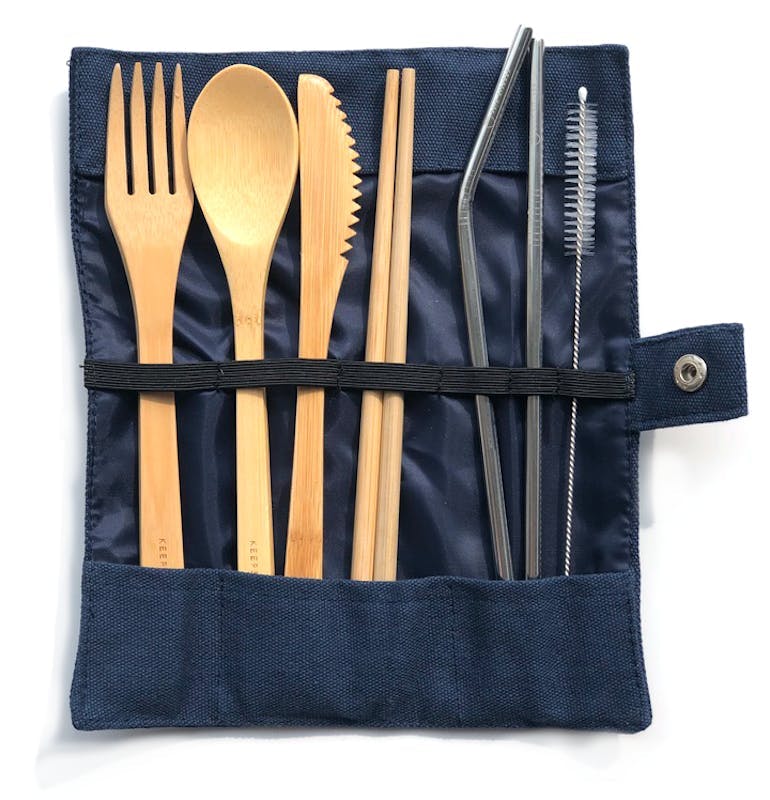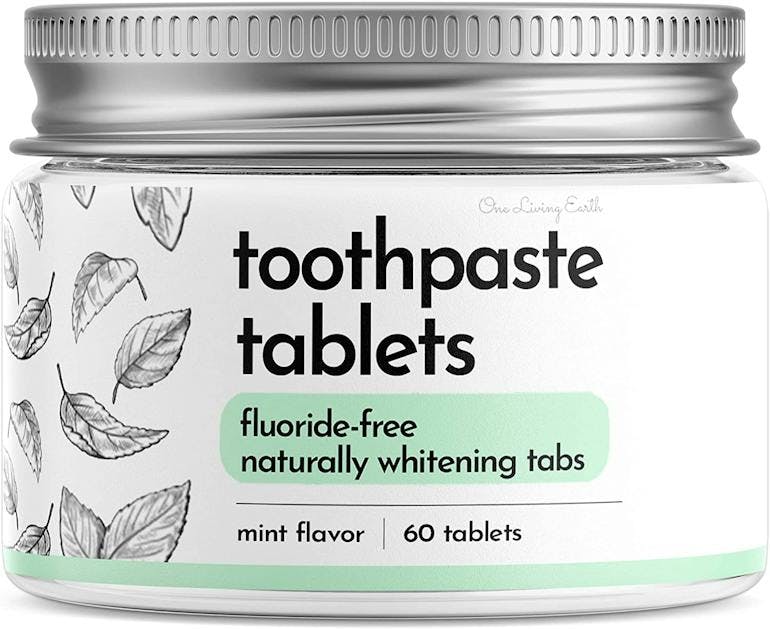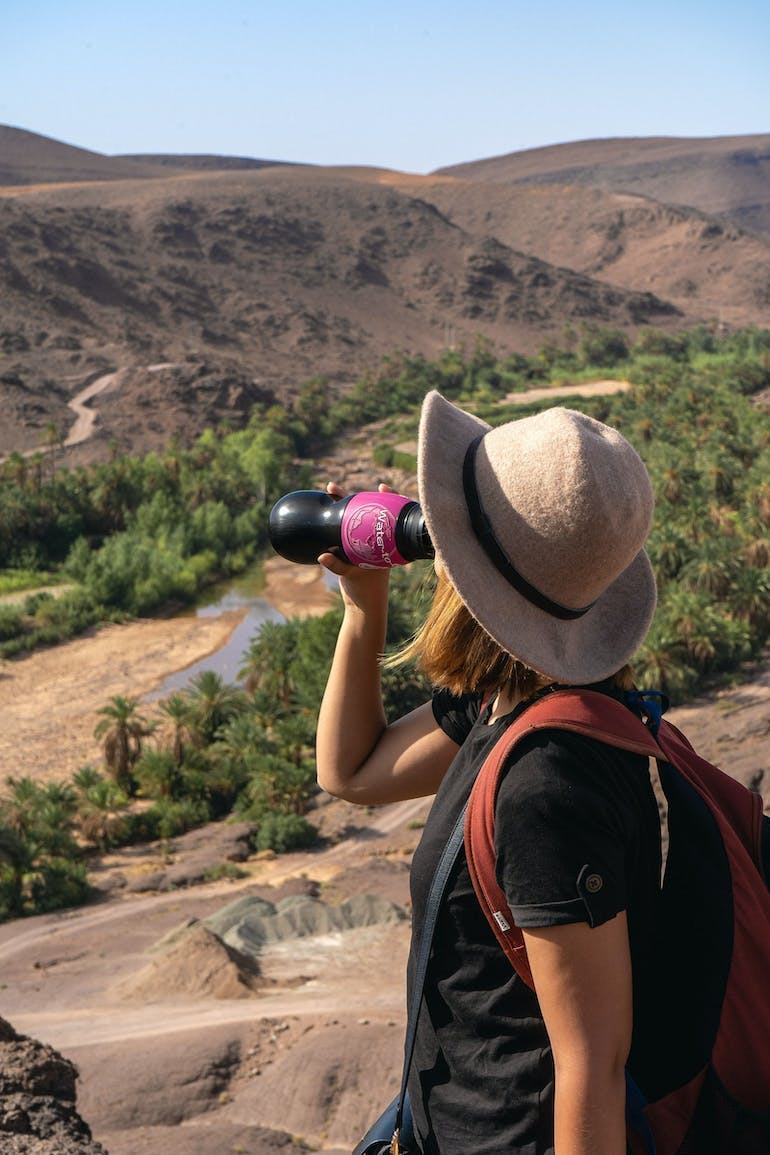Essential Eco-Friendly Travel Products in 2023

31
Mar
Essential Eco-Friendly Travel Products in 2023
Spring has finally arrived and with it comes a time of renewal and change. As we start to clear out the clutter and gear up for summer, many of us may be thinking about our travel plans and ways to make them more sustainable. But let’s face it, the world of eco-friendly travel products can be overwhelming. With so many options out there, it’s hard to know where to begin. That’s why we’re here to guide you through the world of sustainable travel products and offer some recommendations to help you travel more responsibly.
When it comes to innovation, the travel industry may not always be at the forefront like, say, the tech industry. Many of the basics of eco-friendly travel have been around for a while – we all know about reusable water bottles and shopping bags, and hopefully, most of us already have at least one of each. But there are still many other areas where we can make sustainable swaps or upgrades. We’re even confident that there are a few eco-friendly travel products out there that might just surprise you!
So, let’s take a closer look at some of the cool and exciting products that are gaining popularity and making sustainable travel easier than ever before. We’ll delve into the details of each product and explain why they are environmentally friendly and why we think they deserve space in your luggage. But before we begin, let’s remember that the most sustainable option is always to use what you already have and reduce unnecessary consumption.
Reusable Utensils
Bringing your own set of utensils to avoid using plastic ones that are often provided with meals on the go is an easy win. When it comes to choosing reusable utensils for travel, there are several different materials to consider, including bamboo, stainless steel, silicone, and other materials. Each has its own set of advantages and disadvantages, and which one is better for the environment depends on a number of factors.
- Bamboo Utensils: Bamboo utensils are made from a renewable resource and are biodegradable at the end of their life, making them generally considered to be the most sustainable option from an eco-friendly point of view. They are lightweight and easy to carry, so they are a popular choice for travelers. However, some bamboo utensils may be coated with synthetic materials, such as polyurethane, which can reduce their biodegradability. Additionally, bamboo utensils can sometimes absorb flavors or odors, which may be difficult to remove. One additional consideration is that bamboo knives will have limited sharpness – for example, it may be tough to cut a slice of medium or hard cheese. If you opt for bamboo utensils, we recommend this set from Keepsie Kits.
- Stainless Steel Utensils: Stainless steel utensils are durable, long-lasting, and easy to clean. They are a good choice for those who are looking for a reusable option that can be used for a long time. However, the production of stainless steel requires a significant amount of energy and natural resources. Stainless steel utensils can be better if you prefer the “real” feel of silverware – like a sharper knife – and won’t hold odors like bamboo cutlery. Your set might be slightly bigger and heavier than a bamboo set, but if space and weight aren’t a problem, they’re a great option. We like this set.
- Other Utensils: Silicone is a synthetic material that is often used in reusable utensils because it is lightweight, flexible, and easy to clean. It is also BPA-free and can withstand high temperatures. However, silicone is made from petroleum, which is a non-renewable resource, and the production process can be energy-intensive. We can also now find ‘wheat straw’ utensils on the market, such as this set, which is both biodegradable and dishwasher-safe!

Eco-Friendly Toiletries
Opting for natural, organic, and biodegradable toiletries that are free of harsh chemicals and packaged in compostable or recyclable materials are a great way to up your sustainable travel game. A nice side benefit is that these eco-friendly travel products are typically also liquid-free, making them lightweight and super easy to pack without risking your liquid allowance.
Toothpaste and mouthwash tablets are popular eco-friendly alternatives to traditional toothpaste and mouthwash products. These concentrated tablets come in a small, compact form and can be used without water. They often come in plastic-free packaging, which reduces plastic waste. Because they’re dry tablets (about the size of a mint), you can conveniently pack the exact number of tablets you’ll need on your trip. So, use only what you need, and reduce waste and water usage – win-win!
- Toothpaste Tablets: Toothpaste tablets are typically made from natural ingredients and come in a variety of flavors. To use them, you simply chew the tablet to create a paste, then brush your teeth as you would with traditional toothpaste.
- Mouthwash Tablets: Mouthwash tablets work in a similar way. You dissolve them in water to create a solution that you can swish around in your mouth to freshen your breath and kill bacteria. Like toothpaste tablets, mouthwash tablets come in a variety of flavors and are made from natural ingredients.
Some people may find that toothpaste and mouthwash tablets take some getting used to. Chewing the tablet to create a paste can feel different than squeezing traditional toothpaste out of a tube, and dissolving a tablet in water may require a little extra effort compared to using a pre-mixed mouthwash. Additionally, some toothpaste and mouthwash tablets may not contain fluoride, which can be a concern for those who want to ensure they are protecting their teeth against decay.

Shampoo and solid deodorant bars are two examples of solid toiletry products that are becoming increasingly popular as eco-friendly and sustainable alternatives to traditional liquid products. Both typically use less packaging and have a lower carbon footprint. They are also often more compact and lightweight, making them convenient for travel or for use in smaller spaces. Additionally, many people find that these solid products last longer than their liquid counterparts, which can save money in the long run.
- Solid Shampoo: Shampoo bars are solid bars of soap-like material that are specifically designed to be used as shampoo for hair. They typically contain natural ingredients like oils and herbs and are free from harsh chemicals and preservatives. To use a shampoo bar, you simply wet your hair and the bar, rub the bar onto your hair to create a lather, and then rinse it out.
- Solid Deodorant: Solid deodorant bars are similar in concept, but are designed to be used as an alternative to traditional stick or spray deodorants. Like shampoo bars, they are typically made from natural ingredients and free from harsh chemicals. For some solid deodorant bars, you may need to wet the bar before applying. The natural ingredients in the bar help to absorb moisture and neutralize odor.
While solid shampoo and solid deodorant bars are generally safe and effective, remember that everyone’s hair and skin are different. Double-check the packaging instructions and ingredients before using a new product for the first time.
Soap Sheets
OK – these are so cool! Soap sheets are an innovative alternative to traditional liquid or bar soap. They come in a small, compact sheet form, usually packaged in a reusable container, making them an ideal choice for eco-conscious travelers. To use a soap sheet, simply wet your hands or body and then take out one sheet. Rub the sheet between your hands or on your body to create a lather, then rinse off with water. Soap sheets are versatile and can be used for hand washing, body washing, and even for cleaning dishes. Watch how excited we were to try these!
From an environmental perspective, soap sheets are a great option as they typically come in minimal or zero packaging, reducing waste. They also don’t contain any plastic, which is a common component in many traditional liquid soap bottles. Soap sheets are often made with natural ingredients, making them biodegradable and safe for the environment.
From a traveler’s perspective, soap sheets are incredibly convenient. They’re lightweight and easy to pack, taking up minimal space in your luggage or backpack. They’re also TSA-approved, so you can bring them in your carry-on without any issues. Soap sheets are also great for camping or outdoor activities where access to running water may be limited.
One potential downside of soap sheets is that they may not lather as well as traditional soap. Some people may also find the texture of the sheets to be a little unusual compared to the feel of traditional soap. Additionally, soap sheets may not be as cost-effective as traditional soap, as you’ll need to purchase them more frequently due to their small size.
As far as eco-friendly travel products go, soap sheets are the most exciting new product we’ve discovered recently!
Liquid-Free Laundry Detergent
Liquid-free laundry detergent is a popular option for people who want to be able to do laundry on the go without carrying bulky liquid detergent bottles. One benefit of liquid-free laundry detergent is that it is more eco-friendly than traditional liquid detergent. These products tend to have a smaller carbon footprint, as they require less energy to manufacture and transport. They also tend to be more compact, which means they take up less space and are easier to transport. You mainly want to look for detergent sheets (or laundry strips).
Detergent sheets are thin sheets of laundry detergent that dissolve in water. They are lightweight, easy to pack, and designed to be used for one load of laundry on the go. To use these pre-measured detergent sheets, you simply add them to the washing machine with your clothes. Truly perfect for travel, it’s easy to carry a few of these with you and wash clothes in a sink or in a traditional machine if you find one along your journey.
It’s important to note that not all liquid-free laundry detergents are created equal. Some may not be as effective at cleaning clothes as traditional liquid detergent, especially for heavily soiled items. Additionally, some liquid-free options may contain harsh chemicals or fragrances that can be irritating to some people. Double-check that you buy an eco-friendly version that will work for you.
Eco-Friendly Sunscreen
Choosing a reef-safe and biodegradable sunscreen that is free of chemicals that can harm marine life is a good way to go for vacations in the sun. Reef-safe sunscreens are designed to protect your skin from the sun’s harmful rays without causing damage to coral reefs and other marine life. Traditional sunscreens can contain ingredients like oxybenzone and octinoxate (types of chemical UV filters), which have been shown to harm coral reefs and other marine organisms. Let there be no confusion: sunscreen is not the leading cause of damage to coral reefs and life below the sea! But, every bit we can do as individual travelers still help.
Eco-friendly reef-safe sunscreens typically use mineral-based ingredients like zinc oxide and titanium dioxide to provide broad-spectrum sun protection. These ingredients are not harmful to coral reefs and other marine life, and they are often more effective at protecting your skin from the sun than traditional chemical sunscreens. In addition to using mineral-based ingredients, many eco-friendly reef-safe sunscreens are also free from other harmful chemicals like parabens and phthalates. They are often formulated with natural ingredients like aloe vera and coconut oil, which can help to soothe and moisturize your skin.
Another resource you can use for choosing eco-friendly reef-safe sunscreen is the Environmental Working Group’s sunscreen guide.
Eco-Friendly Insect Repellent
While you may have heard of reef-safe sunscreen before, eco-friendly insect repellent is a bit more niche. Eco-friendly insect repellent is free of harmful chemicals and instead uses natural ingredients like essential oils and plant-based extracts to keep insects at bay. Some common natural insect repellents include citronella, peppermint, lavender, and eucalyptus.
One benefit of using eco-friendly insect repellents is that they are generally safer for the environment and for people. They are less likely to cause skin irritation and are free from harsh chemicals like DEET, which can be harmful to aquatic life and ecosystems. Additionally, many eco-friendly insect repellents come in recyclable or biodegradable packaging, further reducing their environmental impact. Here’s a DEET-free option with lemon and eucalyptus.
The Environmental Working Group also has a bug-repellent guide you can reference (they support low-DEET options as well as lemon and eucalyptus alternatives).
Microfiber Towel
A quick-drying and lightweight microfiber travel towel is a great alternative to traditional bulky towels. Microfiber towels are a popular choice for many people due to their high absorbency and quick-drying properties. They are made from a blend of polyester and nylon fibers that are woven together to create a soft, durable material.
One of the benefits of microfiber towels is that they are highly absorbent. They can hold up to seven times their weight in water, making them a great choice for drying off after a swim or shower. They are also quick-drying, which can help prevent the growth of mold and mildew. Another benefit of microfiber towels is that they are generally more durable than cotton towels. They are less likely to fray or tear, and they can withstand many washes without losing their softness or absorbency. They are also often lighter and more compact than cotton towels, which makes them a great choice for travel or outdoor activities.
However, there are some potential downsides to using microfiber towels. One issue is that they can shed microfibers when washed, which can contribute to plastic pollution in the environment. Additionally, some people find that microfiber towels are not as soft as cotton towels, which can be a concern for those with sensitive skin. To mitigate the shedding of microfibers, it’s important to wash microfiber towels separately from other clothing items and to avoid using fabric softeners or dryer sheets, which can cause the fibers to become clogged and less effective.
It’s also worth noting that some microfiber towels are made from recycled materials or use more sustainable production methods, so it’s worth checking the label to see if the towel you are considering has any eco-friendly certifications or attributes.
Solar-Powered Charger
When you think of eco-friendly travel products, a solar-powered charger might not be at the top of your mind. But, solar-powered chargers are a popular and sustainable option for charging electronic devices, especially when traveling. Investing in a solar-powered charger can reduce the need to use energy from non-renewable sources, like fossil fuels, while you’re on the go. Here are some of the pros and cons of using a solar-powered charger:
- Pros:
-Renewable Energy: Solar-powered chargers rely on the sun to generate power, which is a renewable and sustainable source of energy.
-Portability: Solar-powered chargers are typically small and lightweight, making them easy to carry with you on the go. They can be a convenient option for outdoor activities or when traveling to remote areas without access to electricity.
-Durability: Solar-powered chargers are typically designed to be durable and can withstand extreme weather conditions, making them a good option for outdoor activities and adventure travel.
-Cost-Effective: While the initial cost of a solar-powered charger may be higher than a traditional charger, over time, using a solar-powered charger can save you money on your electricity bills if you’re using them at home in addition to your travels. - Cons:
-Weather-Dependent: The effectiveness of a solar-powered charger is dependent on the amount of sunlight it receives. In areas with limited sunlight or during periods of cloudy weather, it may not be as effective.
-Charging Time: Solar-powered chargers typically take longer to charge electronic devices than traditional chargers. This can be a drawback if you need to quickly charge your device.
-Capacity: Solar-powered chargers typically have a limited battery capacity, which may not be sufficient for charging larger electronic devices like laptops.
-Environmental Impact: While solar-powered chargers are generally considered to be eco-friendly, the manufacturing process and disposal of solar panels can have an environmental impact if not properly managed.
Overall, solar-powered chargers can be a great option for charging electronic devices when traveling, especially for those who are looking for an eco-friendly and sustainable option. However, it’s important to consider the weather conditions and the capacity of the charger before making a purchase.
Reusable Water Bottle
Bringing your own refillable water bottle instead of buying single-use plastic bottles is something everybody should be doing by now. There are tons of different versions out there now, such as this bottle that conveniently collapses down and stands sturdy when filled with water.
Portable Water Filter
Going one step beyond a reusable water bottle, a portable water filter can be useful in areas where clean drinking water may not be readily available. Portable water filters are an excellent way to ensure that you have access to clean drinking water while traveling, camping, or during emergency situations. There are several different types of portable water filters available, each with its own benefits and drawbacks. Here are some of the most common types:
- Straw Filters: These are small, lightweight filters that you can drink directly from. You simply insert one end of the straw into the water source and suck the water through the filter. Straw filters are great for hiking or other outdoor activities, as they are very portable and easy to use.
- Gravity Filters: These filters use gravity to move water through the filter. You simply fill the top of the filter with water and let it flow through to the bottom, where the clean water is collected. Gravity filters are often used for group camping trips or for emergency situations, as they can filter large amounts of water at once.
- Pump Filters: These filters use a hand pump to move water through the filter. You insert a hose into the water source and use the pump to force the water through the filter. Pump filters are great for situations where you need to filter large amounts of water quickly, but they can be heavier and more cumbersome to use than other types of filters.
- Bottle Filters: These filters are built into water bottles, allowing you to fill up the bottle from any water source and drink clean water directly from the bottle. Bottle filters are great for hiking or travel, as they are easy to carry and use.
- UV Filters: These filters use ultraviolet light to kill bacteria and viruses in the water. You simply immerse the filter in the water and turn it on. UV filters are very effective at killing microorganisms, but they do require batteries or a power source to work.
When choosing a portable water filter, it’s important to consider the type of water you will be filtering, the amount of water you need to filter, and how portable and easy to use the filter needs to be. It’s also important to look for filters certified by reputable organizations like the National Sanitation Foundation or the Environmental Protection Agency, as these filters have been rigorously tested and shown to be effective at removing contaminants from water.
If you are interested in a reusable water bottle that comes with a filter, check out bottles from Water-to-Go (use code YUGEN10 to save 10% off at checkout). These are ideal for long hiking or trekking trips as the filters last about three weeks.

Reusable Shopping Bag
Like water bottles, we really hope you’re already bringing your own reusable shopping bag on your travels to avoid using plastic bags for souvenirs and other purchases. If you’re looking to add to your arsenal, we are in love with nylon Baggus – especially the Baby Baggu that folds down to easily fit in your back pocket.
There are many other eco-friendly travel products that we didn’t go into with this post, including clothes, luggage, makeup, bamboo toothbrushes, toiletry kits, straws, and more. We talk about a few of those options over on this blog post.
It is great to see an increasing number of eco-friendly travel products gaining popularity. It’s an exciting time for sustainable travel, and we can expect to see more innovative products and solutions in the future. We hope this post helped educate you and inspires you to build up your eco-friendly travel products collection so that you can reduce your environmental impact while still enjoying your travels.
This post may contain affiliate links. This means we may earn a small commission if you purchase a product from our link, at no additional cost to you. Any products on this list that we have tried were bought and not gifted or sponsored.





